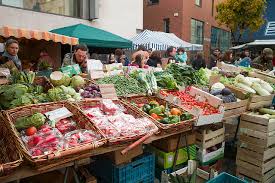Arguably, nothing makes us richer in what matters than eating well, in good company. And eating locally makes us and our community richer on multiple levels. So, “The Joy of Eating Locally” is the topic of Thor’s and my next Potluck Supper & Salon here in Southeast Portland on Sunday, June 1st at 4 p.m. If you’d like to come, let me know.
Salal berries, kind of a fibrous blueberry. Lots of these in my front yard; once a Native American staple here in the Pacific Northwest.
Eating locally pours our food dollars into our local economies, rather than into the coffers of multinational corporations. We are literally supporting our neighbors when we buy local food.
Eating locally gives us fresher food that lasts longer in our refrigerators since it didn’t travel for days or weeks to reach us. Local food is measurably more nutritious than food from faraway (nutrition deteriorates as food ages). Eating locally slashes the carbon footprint of our food (carbon emissions drive climate change). It makes us more resilient to the changes that lie ahead of us. And eating locally builds relationships. Vicki Robbins writes brilliantly about this in her book “Blessing The Hands That Feed Us.”
All that said, I admit I am far from being a locavore (notice that the title of this post is not The Joy of Being a Locavore). For example, I’m addicted to coffee. That divine substance is only grown in warm climates thousands of miles from Oregon, like in Costa Rica, where I did my first volunteer vacation three months ago. It’s really hard to be a locavore. The best account I’ve ever read of a year of locavore life is Barbara Kingsolver’s book “Animal, Vegetable, Miracle” (see my page of good books).
Salmon swimming upriver, from the ocean, back to its birthplace where it will spawn and then die. Incredibly nutritious to our bodies, I think also to our spirits.
Here in the Pacific Northwest, salmon is so central to the natural food chain that it is almost revered. We like to buy salmon from the Native American fishermen who catch it from the Columbia river and sell it at Cascade Locks, right under the Bridge of the Gods. Once a fisherman gave us a discount because the salmon was bruised from a seal that had almost caught it (I used that detail in my novel Revelle).
At my house, we shop at farmers’ markets four months of the year. Thor leads the charge on this and all grocery shopping, since he is the foodie in the house. Farmers markets can be sociable affairs that involve running into friends and neighbors, swapping favorite recipes, etc. One year Thor discovered a man making and selling chipotle pesto. The delicious Chipotle Pesto summer lives on in our memories. We wish we could find him again. But this summer we will probably discover another wonderful, creative grower or local product.
What food that is local to you do you love the most? Have you ever had an interesting conversation with someone who grows, raises or catches food?




I live in the sub-arctic presently. What can I eat that is local? Salmon, char, some shell-fish. I used to eat caribou but we can’t get it anymore - it was hunted out. As to all the other lovely things I like to cook and eat - all trucked in from Quebec and beyond. In the fall there is a very very small farmer’s market. I’ve stopped eating meat other than fish which makes my fella nuts but then he has stopped reading fiction so it’s a draw. Nice to find you.
Jan, your comment brought a smile to my face, especially the second to last sentence. (I’m not smiling about the caribou having been hunted out.) Your point is an excellent one — many regions of the world, especially the cold ones like yours, yield few types of food, and in sparser quantities, than the fertile valley regions.